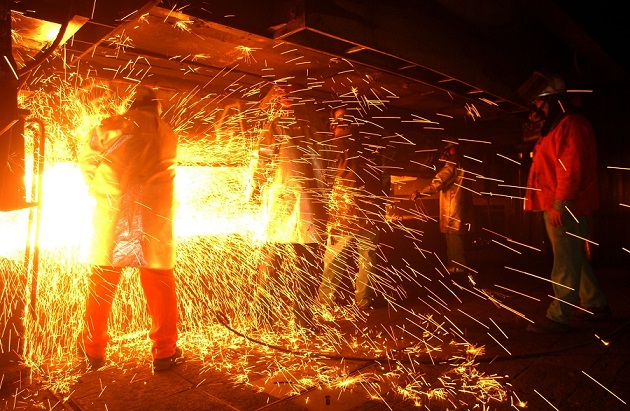Steel will remain the dominant raw material in car production despite tougher competition from rivals, experts say.
Steel makers are offering lighter, more durable products to maintain their dominance against aluminium and plastics producers as the preferred raw material used in vehicle production. Right now steel and iron account for an estimated 71 percent of the material used in a car. By comparison, aluminum accounts for 9 percent and plastics, including carbon fiber, for 8 percent, according to estimates from Frost & Sullivan.
However, steel makers are facing tougher competition from aluminum and plastics makers, which are both poised to increase their shares by 2020 (see chart below). The use of aluminium is forecast to grow to 11 percent in 2020, according to Frost & Sullivan, while steel and iron use is foreseen falling to 65 percent by 2020. Aluminum is being used more often because it is up to 30 percent lighter than steel, IHS Global analyst Julia Mihalkina said.
Changing mix
Forecast materials mix in cars 2013-2015 vs. 2018-2020
Steel/iron71% 65%
Aluminium9% 11%
Plastics8% 9%
Other12% 15%
All material makers are seeking ways to help automakers reduce overall vehicle weight because lighter cars burn less fuel and produce fewer emissions. Carmakers are under pressure to cut fleet CO2 emissions in Europe to 130 grams per kilometer by 2015 from 132.4g/km in 2012. A tougher goal of 95g/km by 2020 is being debated in Brussels.
While steel’s share in cars will decline, Mihalkina expects that it will remain the predominant material in car production, with advanced steel continuing to take an increasing share of that market. One reason for this is because steel beats aluminum on price (see chart below). “In cases where weight becomes less important, the high cost of alternative materials, such as aluminum or composites, makes steel the first-choice material for car production,” Mihalkina said. “High availability will also keep steel prices increasing slowly and steadily, rather than fast and sharp.”
ArcelorMittal, the world’s largest steel maker, is reacting to the demand to reduce weight without sacrificing on safety by launching new products. The supplier expects automakers to start using its lightweight steels in their vehicles’ doors as early as next year because the company says its solution can deliver a 27 percent weight and cost savings.
Thinner steel
ArcelorMittal head of global r&d Greg Ludkovsky said that major carmakers from Europe, North America and Asia have expressed an interest in the company’s door solution, which combines existing high-strength steels and ultra high-strength steels to reduce the weight of the baseline compact car’s door from 18.3kg (about 40 pounds) to 13.3kg.
Big differences
Approximate 2012 prices in $ per metric ton for key raw materials
Steel350
Aluminium2,400
Magnesium 3,400
Carbon fibre 11,000
Titanium12,500
Part of the weight savings is achieved by using thinner steel for the outer door panel, Ludkovsky said. “You may pay more per pound, but the amount of the material you need is significantly less,” Ludkovsky told Automotive News Europe. He declined to say how much more expensive the material is compared with traditional steel or quantify how much less material would be needed to achieve the same level of crash protection.
Suppliers are increasingly asked to deliver lighter-weight, higher-strength steel than they have in the past, without compromising robustness and crash performance. Mihalkina said more than half of the steel used in automotive bodies includes some form of advanced high-strength steel.
Examples of cars with low-weight, high-performance steel include the Mercedes-Benz S class and Peugeot’s new 208, 2008 and 308. The use of lightweight, high-strength steel as well as aluminium and plastic composites helped reduce the weight of the new 308 by 140kg compared with the model it replaced, Laurent Declerck, project director for the new Peugeot 308, told Automotive News Europe. The lighter car emits a low of 85g/km of CO2 compared with 95g/km for the old model.
“We are really paying attention to details when trying to reduce car weight,” Declerck said, “and the use of high-performance steel is one way that we are doing that.”

